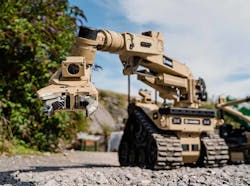Army approaches industry about robotic manipulator arms for bomb disposal with unmanned ground vehicles
PICATINNY ARSENAL, N.J. – U.S. Army bomb disposal experts are reaching out to industry to find companies able to design a robotic manipulator arm to help explosive ordnance disposal (EOD) experts detect, identify, disable, and dispose of chemical, biological, radiological, and nuclear (CBRN) explosives.
Officials of the Army Contracting Command - New Jersey Close Combat, on behalf of the Army Program Manager for Close Combat Systems at Picatinny Arsenal, N.J., issued a request for information (W15QKN-23-Z-0U7W) on Tuesday for the Highly Dexterous Manipulation-Robotic Arms project.
This project seeks to gain information on mature enabling technologies available for designing robotic arms with dexterous fingers with near-human flexibility and greater-than-human strength.
These robotic arms should be able to grasp an object with an end-effector and manipulate it with another end-effector with intuitive systems controllers that include force feedback and haptic feedback. Information from this notice will help the Army shape future requirements and acquisition programs for robotic payloads.
Concerning technologies for the manipulator arms, Army researchers want information about:
-- six degrees-of-freedom to include shoulder roll and pitch, elbow roll and pitch, and wrist roll and pitch per manipulator;
-- forward reach of at least 50 inches, an upward reach of at least 36 inches, and downward reach of at least six inches below the platform’s ground plane;
-- weight of no more than 60 pounds;
-- lift capability of at least 55 pounds with one manipulator, and at least 65 pounds with more than one manipulator;
Related: iRobot lands another Navy contract for ground robots that assist bomb-disposal technicians
-- full extension lift capability of at least 30 pounds with one manipulator, and at least 50 pounds with more than one manipulator at full extension;
-- dexterity sufficient to manipulate small wires, zipper fasteners, screws, door handles, push buttons, and similar objects;
-- ability to manipulate large bombs and artillery shells like 155-millimeter artillery projectiles; and
-- have a multi-shot disruptor tool that provides accurate and precise liquid and solid-shot explosive hazard disruption.
The robotic manipulator arm should be:
Related: Sandia software tested on bomb-disposal robot
-- compatible with Army percussion actuated non-electric (PAN) disruptor ammunition;
-- capable of remotely loading and unloading multiple disruptor ammunition and projectile options in most orientations;
-- able to aim the disruptor; and
-- accurate enough to hit a 9-volt battery from 30 feet away.
The program's precision aiming manipulator should be capable of fine adjustments for positioning and aiming the multi-shot disruptor, and should be able to perform post disruption procedures of explosive hazards.
The robotic manipulator arm should have a maximum aiming resolution pan and tilt movement of 0.625 inches horizontally and vertically at 10 feet of aiming resolution; forward reach of at least 55 inches; weigh no more than 69 pounds; be able to lift at least 65 pounds; be able to lift at least 12 pounds at full extension; and be able to go 300 shots before maintenance.
Video should provide operators with situational awareness around the robotic platform as well as close-up views of manipulated items. The arm should be able to work in a chemical, biological, and radiological environment.
Companies interested should email responses no later than 24 March 2023 to the Army's Yolie Marie Davila at [email protected] and Carolina Ayala at [email protected].
More information is online at https://sam.gov/opp/5af691db075449348e7d0bade71a2c1e/view.
About the Author
John Keller
Editor-in-Chief
John Keller is the Editor-in-Chief, Military & Aerospace Electronics Magazine--provides extensive coverage and analysis of enabling electronics and optoelectronic technologies in military, space and commercial aviation applications. John has been a member of the Military & Aerospace Electronics staff since 1989 and chief editor since 1995.
